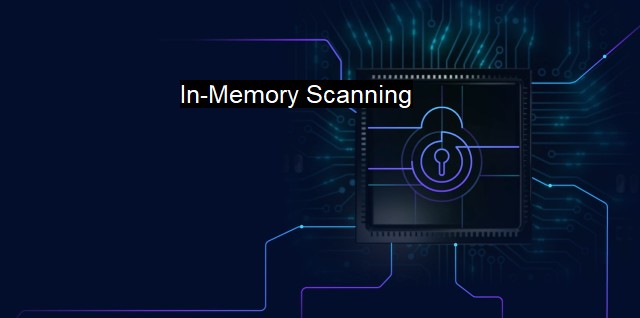What is In-Memory Scanning?
In-Memory Scanning: Revolutionizing Cybersecurity by Proactively Detecting and Preventing Malware in Real-Time
In the context of cybersecurity and antivirus solutions, In-Memory Scanning, sometimes referred to as RAM scanning, is a technological process used to scan and monitor a computer's memory for malicious activities or harmful pieces of code. It is a fundamental component of certain antivirus programs, aimed at spotting and mitigating potential threats that cybercriminals could use against individuals, organizations, businesses, and e-commerce traffic.The ensuing advantages of this type of scanning are numerous. Unlike traditional antivirus systems that only monitor apparent artifacts like files and programs, In-Memory Scanning dives deeper. It scrutinizes data and executable codes currently loaded in the system's memory which provides a wide-ranging view of the operations being executed in real-time and an instantaneous pursuit of threats before potentially being written to disk. This is crucial in combating sophisticated attacks that may go undetected by surface-level surveillance methods.
Cyber threats have incrementally become more seasoned and insidious. Modern attackers often leverage advanced techniques like code obfuscation and metamorphic malware that change their characteristics during execution to bypass conventional checks. Therefore, In-Memory Scanning represents a proactive approach to detect and halt such threats. It provides an extra line of defense alongside the conventional virus detection methods.
Analysts concerned about cloud security often apply In-Memory Scanning. Today, virtual machines and cloud resources running sensitive workloads are prime targets for cyber-attacks. the deployment of In-Memory Scanning provides real-time threat detection, ensuring malware does not persist in system memory where it could disrupt the availability and integrity of cloud services.
One prevalent kind of attack that can be detected using In-Memory Scanning is the 'fileless' malware attack. These stealthy forms of malware operate directly from memory rather than being downloaded on the machine's hard drive, which renders them virtually invisible to traditional antivirus solutions. They leverage reputable existing programs or scripts to execute malicious actions. Because fileless malware operates from memory, In-Memory scanning is perfectly poised to unearth and eradicate such threats.
Monitoring system memory in real-time might burden system resources, but the efficiency of In-Memory Scanning is outstanding. It ensures negligible performance impact due to its optimized scan process and scheduler that ensures the process only performs scans during idle times or when the system resources are not heavily used.
Critically, In-Memory Scanning does not equate to replacing traditional antivirus software. Instead, it adds an extra, structured layer to tackle data threats that standard security controls have missed. This leeway for integration provides users an opportunity to layer their cybersecurity approach and strategically protect against both known and unknown threats to their data integrity.
Other notable applications of In-Memory Scanning are found in Advanced Persistent Threat (APT) protection systems and Zero-day exploit mitigation. Often, these attacks make use of encrypted payloads delivered via email or other communication systems, a direct injection into the system memory. This makes them selectively dangerous and harder to detect. with strategically deployed RAM-based scanning combined with behavioral analysis, these attacks can be identified and neutralized in a timely fashion.
In-Memory Scanning is an innovative and increasingly essential aspect of contemporary antivirus and cybersecurity solutions. By monitoring and analyzing the system's memory in real-time, it posses a unique ability to spot hidden threats and malicious activities that might otherwise bypass traditional controls. As cyber threats continually evolve into increasingly sophisticated forms, an in-depth approach like In-Memory scanning is needed for comprehensive cybersecurity. it's always important to remember that, no individual method is foolproof alone, and best practice would advocate a layered and integrative approach, combining old school strategies and novel defenses like In-Memory scanning to keep your digital environments safe.

In-Memory Scanning FAQs
What is in-memory scanning in cybersecurity?
In-memory scanning refers to a technique used by antivirus software to detect malicious code that resides in the computer’s active memory. It is an important defense mechanism as attackers increasingly use techniques that don’t always involve the writing of malicious files to disk.Why is in-memory scanning important for antivirus software?
In-memory scanning is important for antivirus software because it helps detect and prevent memory-based attacks that bypass traditional detection methods. These attacks can be especially dangerous as they can be used to carry out advanced persistent threats (APTs) and steal sensitive data.How does in-memory scanning work?
In-memory scanning works by scanning the computer’s active memory for patterns that match known signatures of malicious code. It can also use behavior-based analysis to identify suspicious activities in memory that may indicate a malware infection.What are the benefits of using in-memory scanning?
The benefits of using in-memory scanning include improved protection against memory-based attacks and the ability to detect and block malware that is designed to evade traditional detection methods. This can help safeguard critical data and systems against theft and compromise. Additionally, in-memory scanning can be quicker and more efficient than traditional file-based scanning, since it doesn’t require the antivirus software to scan every file on the system.| | A | | | B | | | C | | | D | | | E | | | F | | | G | | | H | | | I | | | J | | | K | | | L | | | M | |
| | N | | | O | | | P | | | Q | | | R | | | S | | | T | | | U | | | V | | | W | | | X | | | Y | | | Z | |
| | 1 | | | 2 | | | 3 | | | 4 | | | 7 | | | 8 | | |||||||